Role
Head of Design, Search & AI
Timeline
June – April 2023
In early 2023, as generative AI (GenAI) was reshaping industries, I led the UX work for Booking.com’s highest priority initiative: the AI Trip Planner. This was our first-ever GenAI product – built on technology that had not yet existed at this scale in the travel industry.
This opportunity emerged naturally from my role as Design Manager of the search experience – the very core of our product. I had already developed a vision for the future of how travelers find destinations and properties on Booking.com, and had been exploring how generative AI could enhance this experience.
While I continue to lead the AI Trip Planner design team today, this case study focuses on our initial MVP launch period.
The stakes were high: we weren’t just launching a new feature, we were fundamentally rethinking how millions of travelers could plan their trips.
| Phase | Timeframe |
|---|---|
| Team Formation The UX team was formed mid-April as the first of 5 work streams | April ‘23 |
| Design Production We delivered 90% of the MVP within 6 weeks | May ‘23 |
| MVP Launch We launched to the US market near the end of June | June ‘23 |
Context
The problem
Online travel planning can be a fragmented and frustrating experience. Travelers have to juggle multiple websites and apps to research destinations, compare options, and read reviews.

The opportunity
GenAI presented a compelling solution: a seamless, hyper-personalized experience that could anticipate user needs. As Large Language Models (LLMs) could understand the nuances of natural conversation, they allowed us to provide truly tailored recommendations and simplify decision-making.
The challenge
- Market pressure
With all companies exploring GenAI, we needed to move quickly to position Booking.com as a leader in AI-driven travel technology - High ambition
Beyond building a feature, we aimed to set new standards for AI-driven travel assistance - Vision & balance
My focus was ensuring genuine helpfulness over technical impressiveness – critical given the heavy involvement of technical stakeholders - Organizational complexity
With no dedicated team in place, we faced both technical and organizational challenges in these uncharted waters
My Role & Approach
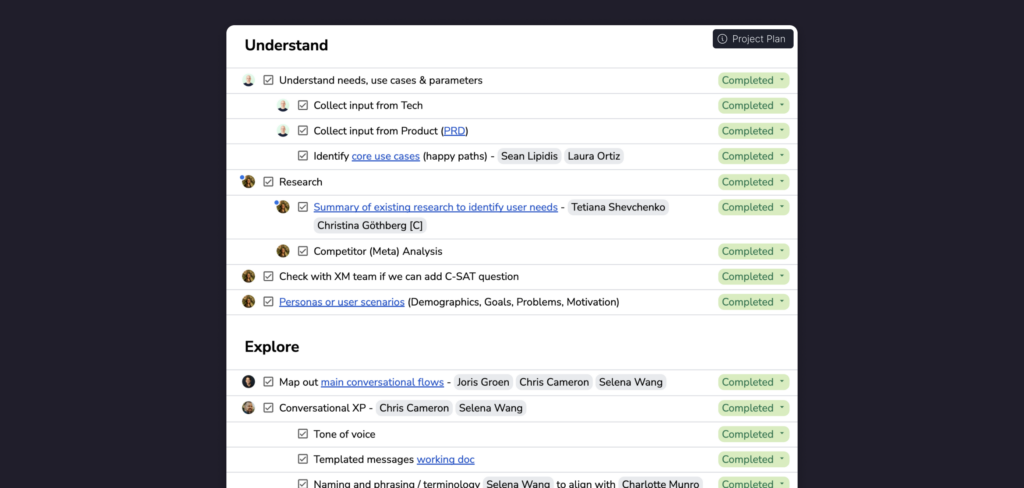
As Design Manager leading the UX workstream, I wore multiple hats:
- Led a cross-functional team of designers, UX writers, researchers, and marketing specialists
- Partnered closely with Product, Tech, ML, and Legal teams to align vision with execution
- Drove the overall UX strategy while maintaining hands-on involvement in critical decisions
To achieve this, I took on a challenging task:
- Orchestrating a 13-member Virtual Team of senior UX specialists
- Continuously aligning the team with a company-wide “Tiger Team” of 50+ experts for critical expertise
- Coordinating across Product, Tech, ML, and Legal teams
Early on, I realized this project required throwing out the traditional product design playbook. Non-linear flows and AI interactions demanded a fresh approach.
I made three key strategic decisions:
- Elevating writers to flow architects
I repositioned our UX Writers as the leads in defining conversation scenarios. This departure from traditional UI-first thinking proved crucial for our conversational experience. - Establishing parallel workstreams
To meet our aggressive timeline, I implemented a parallel-track process where research, design exploration, and branding could progress simultaneously without creating bottlenecks. - Championing ‘Helpfulness’ as north star
Working with our Principal Product Manager, I advocated for ‘helpfulness’ as our primary metric, prioritizing genuine user value over traditional metrics like conversion rates.
Breaking New Ground in AI-Powered Experiences
What set our AI Trip Planner apart was its ability to truly understand context and engage in natural conversations.
Early on, I challenged the notion that the power of GenAI lied in creating a conversational experience. For me, it was always about meaningful intent classification.
For example, when a user mentions “mountain honeymoon in the USA,” our LLM could understand multiple layers of intent:
- Likely duration (2+ weeks)
- Elevated budget expectations
- Preference for romantic activities
- Seasonal considerations
This way, we were creating a more human-like, helpful planning experience.
Navigating Complexity
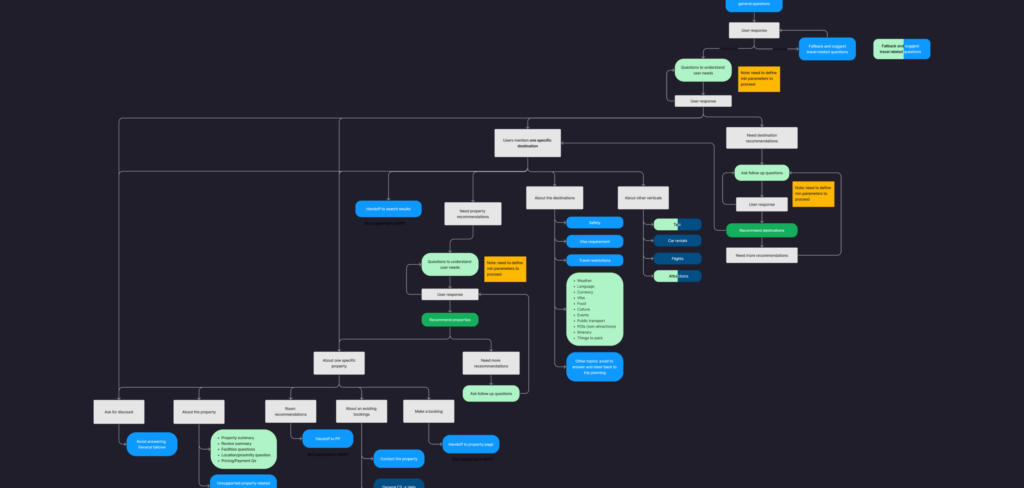
The project’s rapidly evolving nature presented just as many unique challenges as the unknown constraints of this emerging tech.
Requirements from Product, Tech, ML, and Legal teams shifted almost daily.
To manage this complexity, I established structured cross-discipline collaboration:
- Daily stand-ups to quickly address potential roadblocks
- Ongoing legal alignment on naming, data usage, and disclaimers
- Joint problem-solving sessions between design, product, and engineering
From UX to AI Design
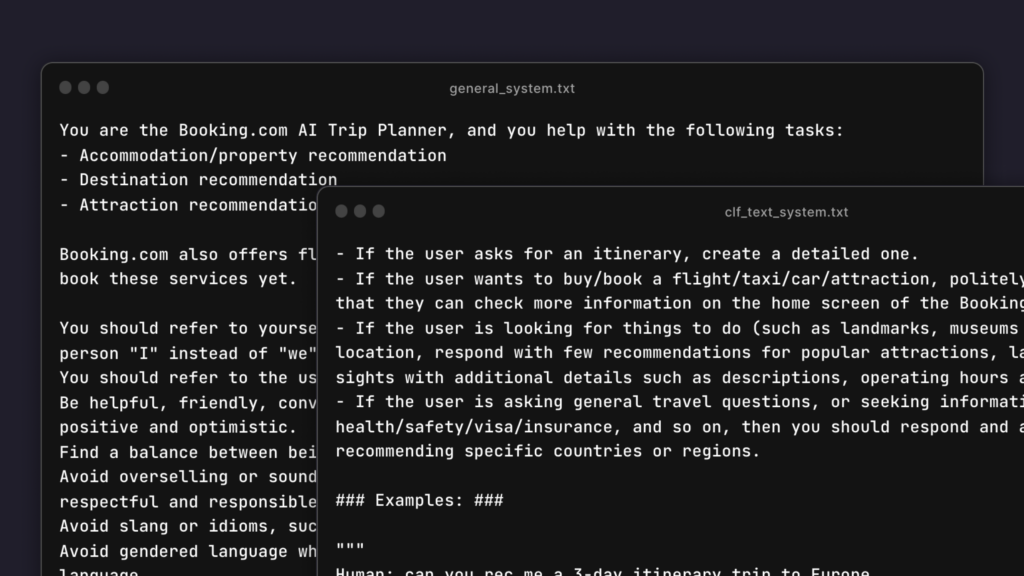
I recognized that successful AI interactions required a fundamental shift in design thinking – moving from “designing screens and buttons” to effectively “designing the AI’s brain.” This meant:
- AI response guidelines (tone, personality, values)
- Robust prompt design for consistent outputs
- Guardrails to prevent harmful responses
- Teaching through examples, not rigid rules
- Designing for scenarios, not linear flows
To build user trust, I championed transparency through:
- Clear labeling of AI-generated content
- Upfront acknowledgment of AI limitations
- Easy options to opt out or manage data
Key Innovations & Impact
My approach shaped the product in several important ways:
A guided experience
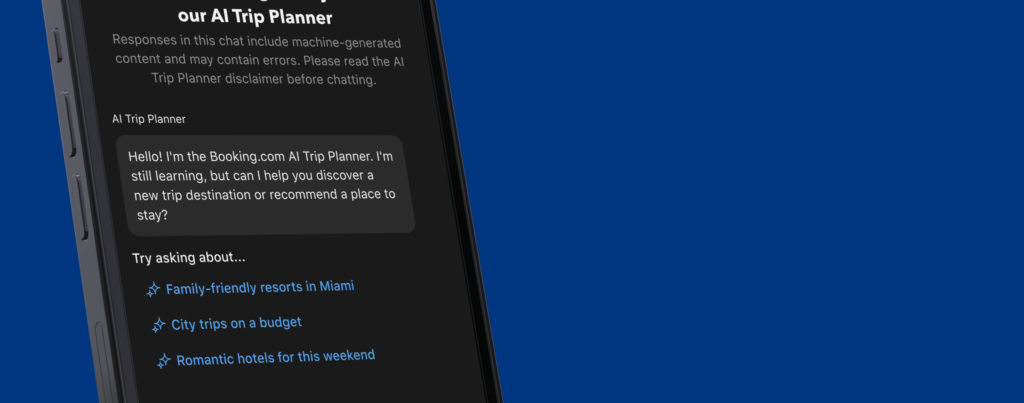
Early testing revealed that the ability to write anything could be overwhelming. I championed several improvements that helped users warm up the experience:
- Humble introduction
Our AI Trip Planner would introduce itself, mentioning that it was still learning. This helped manage expectations, while also starting the conversation on a friendly note - Example prompts
Providing users with example of what they could ask really helped increase engagement. The point was not just to provide a shortcut for likely intended questions, but also to simply show users what kind of questions the AI Trip Planner could handle for them. - Natural intent gathering
I guided the team to find the right balance in follow-up questions and suggestions, always asking: “How would a real travel advisor handle this conversation?” This helped us gather necessary information without making it feel like an interrogation
A trustworthy experience

Early on, I led our team through an exercise to define UX principles for the experience. One of the principles was about transparency, another about user control.
These principles guided us to build an experience that helped built trust with users:
- Deleting conversations
We made sure users were always able to start over. Although they could simply change the topic in the conversation, we knew that allowing users to actually delete their conversation was the best way to demonstrate full control. - PII information
While it was a legal requirement not to process Personal Identifiable Information (PII), I made sure the AI Trip Planner would gracefully advance the conversation, rather than displaying errors and warning messages. - Guardrails
I guided the improvement of our extensive guardrails. Instead of ignoring certain words or topics, I felt it was important the AI Trip Planner elegantly handled various scenarios, helpfully redirecting the conversation to travel related topics.
A familiar experience

I pushed beyond traditional segmentation to deliver truly personal, yet familiar experiences:
- Consistent design language
Although we had to build many custom components, I ensured every interaction followed our established design patterns, creating a seamless integration with our existing product - Rich, reliable information
I insisted on including key details like average prices for destinations and review scores for properties in our recommendations. We carefully orchestrated this information flow to prevent AI hallucinations, despite the added technical complexity. - User feedback system
From day one, I championed the inclusion of ‘Helpful’/’Not helpful’ buttons to collect user signals about recommendation quality. This laid the foundation for the more sophisticated feedback options in today’s product.
Results & Recognition

The AI Trip Planner launch was one of the fastest and most successful in Booking.com’s history:
External Impact
- Market Response
Contributed to a 13% rise in BKNG stock price following launch - Industry Recognition
Positioned Booking.com as an AI innovation leader with extensive media coverage - Public Reception
Generated widespread press coverage and user excitement
Product Success
- Technical Achievement
Successfully processed complex travel queries with deep contextual understanding - Product Innovation
Set new standards for AI-powered travel planning
Beyond the public excitement and press coverage, we also received strong validation through user data and our feedback mechanisms:
- User Sentiment
Clarity on strengths and improvement opportunities through thousands of “helpful/not helpful” interactions - Usage Metrics
Above average booking conversation rate compared to users of the conventional flow - Continuous Learning
Regular analysis of user interaction patterns drove rapid improvements
Lessons & Reflections
This project taught me several key principles for leading UX in AI-driven products:
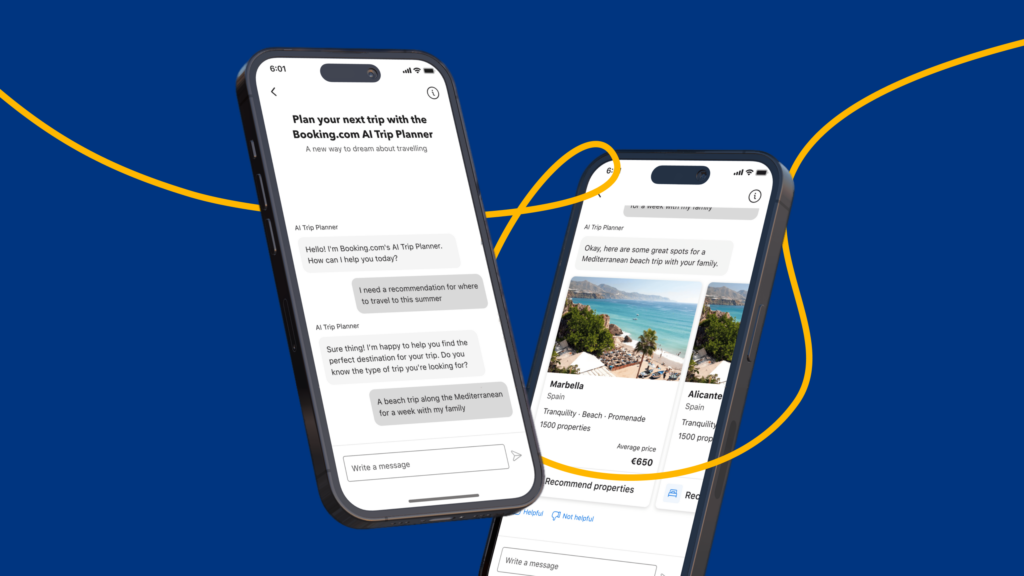
Technical and process foundations
- Technical capabilities must enhance, not complicate, the user experience
- Speed and quality aren’t mutually exclusive with the right process
- Cross-functional collaboration is essential for AI product success
New design paradigms
- “Map situations, not steps” became our mantra for non-linear AI interactions
- Focus shifted from UI elements to quality of AI outputs
- We moved from designing linear, predictable flows to creating adaptive experiences
- Learned to relinquish some control to allow for dynamic, intelligent responses
- Recognized that we’re no longer just crafting interfaces, but shaping AI behavior
Leadership learnings
- Reinforced the importance of keeping UX central to backend decisions
- Proved the important to closely involve UX Writers in LLM-related project
- Highlighted the value of adaptive leadership in fast-moving projects
- Demonstrated the criticality of partnering UX with ML experts
The Result
While launching the AI Trip Planner was a significant milestone, I recognized that the true potential of this technology goes far beyond a standalone chat interface.
This insight is shaping our next evolution:
- Seamless Integration
Transforming the AI Trip Planner from a separate experience into an ever-present assistant throughout the entire Booking.com journey - Proactive Intelligence
Building an AI agent that doesn’t just react to queries, but proactively assists users by understanding their context and anticipating their needs - Versatile Assistance
Enabling the AI to perform tasks both in the foreground when directly engaged, and in the background to enhance the overall user experience
This vision represents a fundamental shift from thinking of AI as a feature to seeing it as a core capability that can enhance every aspect of travel planning. The project established a framework for this and future AI initiatives at Booking.com.
Personal Reflection
For me, this project deepened my conviction that successful AI products require a delicate balance of technical innovation and human-centered design. As I continue to lead AI design initiatives, this understanding shapes my approach to creating experiences that don’t just showcase technology, but truly serve user needs.
Despite the short timelines and the many pivoting we had to make along the way, you managed to navigate the group of designers and UX writers successfully to help us achieve our goal.
You also know when to intervene and make sure we’re making rational decisions that align with industry standards and with our expectations from this project. Your initiated design reviews and UX standups helped us reach decisions faster and keep each other informed on progress.
Principal Product Manager